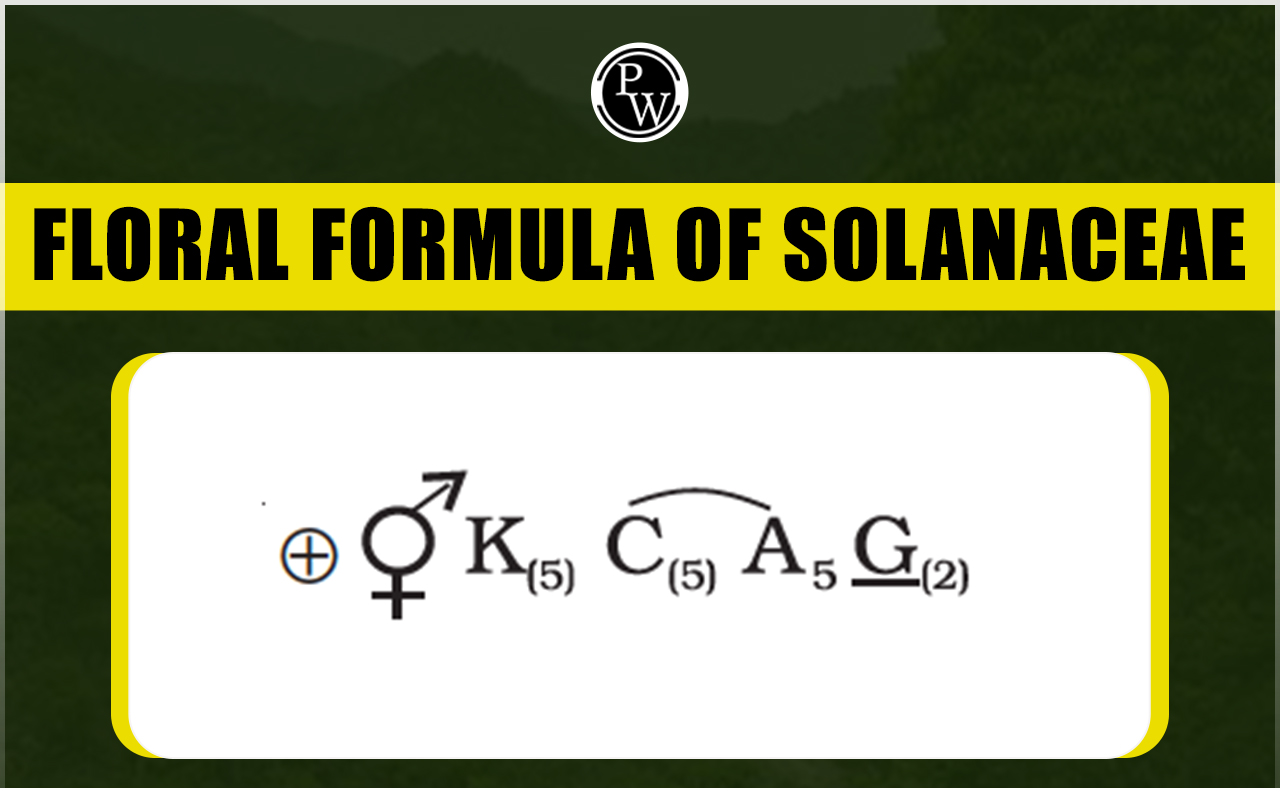

Floral Formula of Solanaceae: The Solanaceae family, commonly known as the nightshade or potato family, includes a variety of flowering plants. This family is referred to as the nightshade family because many of its plants contain toxic alkaloids, and some species grow in shaded areas and bloom at night.
Solanaceae family consists of over 102 genera and 2,280 species, with about 51 species from 16 genera found in Nepal. Economically, this family includes several plants of food value, medicinal importance, vegetables, and ornamentals. The following article provides detailed information on the floral formula of Solanaceae, its characteristics, a diagram, its economic importance, and more.Also Check:
What is the Floral Formula of Solanaceae?
The Solanaceae family, commonly referred to as the 'potato family,' is a prominent group of flowering plants. This family is found worldwide, thriving in tropical, subtropical, and temperate regions. It includes a range of spices, medicinal plants, and key agricultural crops. This family includes vegetables such as potatoes, tomatoes, bell peppers, and eggplants. A floral formula is a symbolic way to describe the different parts of a flower, their quantities, their arrangement, and how they are connected. The typical floral formula for the Solanaceae family is as follows:Symbol Representation of Floral Formula of Solanaceae
The floral formula of Solanaceae is represented by the table below:| Floral Formula of Solanaceae | |
|---|---|
| Symbol | Description |
| ⊕ | Actinomorphic (radial symmetry) |
| ⚥ | Bisexual |
| K(5) | Calyx – 5 sepals, gamosepalous (united) |
| C(5) | Corolla – 5 petals, gamopetalous |
| A5 | Androecium – 5 stamens, polyandrous (free), epipetalous (attached to petals) |
| G(2) | Gynoecium – bi-carpellary, syncarpous (united), superior ovary |
Distribution of Solanaceae Family
The Solanaceae family is globally distributed, with its members commonly found in tropical to temperate regions. These plants are predominantly mesophytes, thriving in moderate environments. Some species are cultivated for their edible fruits and other purposes. The largest genus within this family is Solanum, comprising approximately 2,280 species. One notable species, Solanum xanthocarpum, exhibits characteristics typical of xerophytes, which are adapted to dry conditions.Also Check:
Habit and Habitat of Solanaceae Family
The Solanaceae family, also known as the nightshade or potato family, includes a wide variety of plants and thrives in diverse environments. Here are the key details: Habit of Solanaceae Family- Growth Forms : This family comprises annual and perennial herbs, shrubs, and climbers.
- Stem : The stems can be erect, herbaceous, solid or hollow, cylindrical, branched, smooth, or slightly hairy.
- Root System : Typically, these plants have a main tap root with additional lateral branches.
- Distribution : Members of the Solanaceae family are found worldwide, from tropical rainforests to temperate woodlands, grasslands, and deserts.
- Environmental Adaptations : They can grow in various environments, including terrestrial, mesophyte, wild, and cultivated areas.
Systematic Position of the Floral Formula of Solanaceae
Systematic positions of the Solanaceae are as follows:|
Systematic Position of the Floral Formula of Solanaceae |
|
|---|---|
| Kingdom | Plantae |
| Subkingdom | Tracheobionta |
| Super Division | Spermatophyta |
| Division | Magnoliophyta |
| Class | Magnoliopsida |
| Subclass | Asteridae |
| Order | Solanales |
| Family | Solanaceae |
Features Of the Solanaceae Family
The Solanaceae family, commonly known as the nightshade family, is a vast and varied group of plants that includes numerous species of economic importance. The following are some notable features of this family: 1. Habit: Members can be herbs, shrubs, small trees, vines, or lianas. 2. Leaves: Typically alternate, simple, and without stipules. 3. Flowers:- Usually bisexual and actinomorphic (radially symmetrical).
- Five fused sepals and five fused petals.
- Five stamens are often attached to the corolla.
- Superior ovary with two fused carpels.
Economic Importance of Solanaceae Family
The Solanaceae family holds significant economic value due to its diverse applications in various fields, such as food, medicine, and industry. Here are some key points with examples:- Vegetables: Plants from this family, including tomatoes, potatoes, capsicums, and eggplants, are widely consumed as vegetables. For instance, the fruits of Solanum melongena (eggplant), Capsicum annuum (capsicum), Lycopersicum esculentum (tomato), and the stem tuber of Solanum tuberosum (potato) are popular vegetables globally.
- Food: Members of the Solanaceae family serve as essential food sources. Potatoes, tomatoes, and brinjals (eggplants) are significant vegetables. Additionally, Physalis manima (sun berry) and Physalis peruviana (Cape gooseberry) are cultivated for their sweet, edible berries.
- Medicines: Several Solanaceae plants have medicinal properties used to treat various disorders. For example, the dried leaves stems, and roots of Atropa belladonna produce atropine, a compound used to relieve pain. Similarly, the dried leaves and roots of Datura metel are utilized in asthma treatment.
- Narcotics: Certain Solanaceae plants, like Nicotiana tabacum and Nicotiana rustica , produce nicotine used in tobacco and cigarettes. The poisonous alkaloid stamina, found in Datura stramonium , makes its seeds and leaves narcotic, occasionally used for criminal poisoning.
- Condiments: The fruits of Capsicum species are commonly used as condiments, adding flavor and spice to various dishes.
- Ornamental Purpose: Many Solanaceae plants are cultivated for ornamental purposes, enhancing home and garden aesthetics. Examples include Petunia nyctaginifolia , Cestrum diurnum , Cestrum nocturnum , and Cestrum elegans , which are popular garden plants.
- Other Uses: Solanaceae plants also contribute to industrial products such as ethanol, syrup, and dextrin. For example, Nicotiana tabacum is used in pesticides and insecticides, and some plants in this family are used in paints and varnishes.
Identifying Characteristics of the Solanaceae Family
The plants described are primarily annual herbs, with trees being rare. Below are the detailed characteristics: Leaves :- Simple and alternate in the vegetative parts
- Opposite near the inflorescence
- Exstipulate (without stipules)
- Reticulate (net-like veins)
- Cymose type, typically axillary or extra-axillary
- Sometimes solitary or axillary
- Ebracteate (without bracts)
- Actinomorphic (radially symmetrical)
- Complete (having all floral parts)
- Bisexual (having both male and female organs)
- Pentamerous (floral parts in fives)
- Hypogynous (ovary is above other flower parts)
- Consists of five sepals
- Gamosepalous (sepals united)
- Persistent and often enlarged in fruit
- Consists of five petals
- Gamopetalous (petals united)
- Various shapes with twisted or valvate aestivation (arrangement of petals in bud)
- Consists of five stamens
- Polyandrous (stamens free)
- Epipetalous (stamens attached to petals)
- Alternate to petals
- Anthers are dithecous (two-lobed), basifixed (attached at the base), and introrse (opening towards the center)
- Bicarpellary (two carpels)
- Syncarpous (carpels united)
- Bilocular (two chambers) with many ovules on a swollen placenta
- Axile placentation (placenta in the center with ovules attached)
- Ovary obliquely tilted
- Style long
- Stigma bilobed or capitate (rounded)
- A berry or a capsule
- Endospermic (containing endosperm)
Some common plants of the Solanaceae Family
The Solanaceae family, commonly known as the nightshade family, encompasses a wide range of plants, including both edible and toxic species. Below is a table that outlines some well-known members of this family:| Some common plants of the Solanaceae Family | |||
|---|---|---|---|
| Plant | Common Name | Edible/Toxic | Notable Characteristics |
| Solanum tuberosum | Potato | Edible | Tuberous root; a key staple food |
| Solanum lycopersicum | Tomato | Edible | Fruit is a berry; a versatile ingredient |
| Capsicum spp. | Peppers (bell, chili, etc.) | Edible | Varying heat levels; used globally in cuisines |
| Solanum melongena | Eggplant | Edible | Purple or black fruit; is featured in many dishes |
| Nicotiana tabacum | Tobacco | Toxic (when consumed) | Leaves are dried and processed for smoking |
| Atropa belladonna | Deadly nightshade | Toxic | Highly poisonous; contains atropine |
| Datura stramonium | Jimson weed | Toxic | Hallucinogenic; highly poisonous |
| Physalis peruviana | Cape gooseberry | Edible | Sweet fruit enclosed in a husk |
Floral Formula of Solanaceae FAQs
Q. What is the formula for a floral formula?
Ans. The floral formula is a standardized method for documenting the structure of a flower. It uses a series of capital letters to represent different parts of the flower: K for calyx, C for corolla, A for androecium, and G for gynoecium. A number indicates the number of each component, and if there are more than 12, the symbol ∞ (infinity) is used.
Q. What is the habitat of Solanaceae?
Ans. Solanaceae are commonly found in secondary vegetation in disturbed areas, but they can thrive in a variety of habitats ranging from deserts to tropical rainforests (Heywood, 1978).
Q. What type of seed is typically found in Solanaceae plants?
Ans. Most Solanaceae plants produce dicot seeds, which have two cotyledons.
Q. What does the term "germination" mean?
Ans. Germination refers to the process by which a seed develops into a mature plant.
Q. What are the key characteristics of Solanaceae?
Ans. Solanaceae can be identified by several key characteristics. They usually have spiral leaves with internal phloem, a perianth with five parts, and a corolla with involute aestivation. They possess a syncarpous gynoecium and multiple ovules in each carpel, capsule, or drupe. These plants can also appear as shrubs, herbs, trees, or lianas.
🔥 Trending Blogs
Talk to a counsellorHave doubts? Our support team will be happy to assist you!

Check out these Related Articles
Free Learning Resources
PW Books
Notes (Class 10-12)
PW Study Materials
Notes (Class 6-9)
Ncert Solutions
Govt Exams
Class 6th to 12th Online Courses
Govt Job Exams Courses
UPSC Coaching
Defence Exam Coaching
Gate Exam Coaching
Other Exams
Know about Physics Wallah
Physics Wallah is an Indian edtech platform that provides accessible & comprehensive learning experiences to students from Class 6th to postgraduate level. We also provide extensive NCERT solutions, sample paper, NEET, JEE Mains, BITSAT previous year papers & more such resources to students. Physics Wallah also caters to over 3.5 million registered students and over 78 lakh+ Youtube subscribers with 4.8 rating on its app.
We Stand Out because
We provide students with intensive courses with India’s qualified & experienced faculties & mentors. PW strives to make the learning experience comprehensive and accessible for students of all sections of society. We believe in empowering every single student who couldn't dream of a good career in engineering and medical field earlier.
Our Key Focus Areas
Physics Wallah's main focus is to make the learning experience as economical as possible for all students. With our affordable courses like Lakshya, Udaan and Arjuna and many others, we have been able to provide a platform for lakhs of aspirants. From providing Chemistry, Maths, Physics formula to giving e-books of eminent authors like RD Sharma, RS Aggarwal and Lakhmir Singh, PW focuses on every single student's need for preparation.
What Makes Us Different
Physics Wallah strives to develop a comprehensive pedagogical structure for students, where they get a state-of-the-art learning experience with study material and resources. Apart from catering students preparing for JEE Mains and NEET, PW also provides study material for each state board like Uttar Pradesh, Bihar, and others
Copyright © 2025 Physicswallah Limited All rights reserved.











